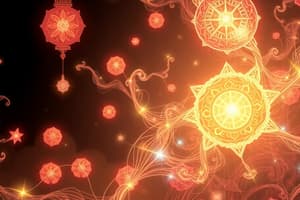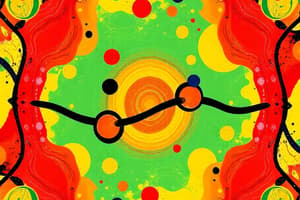Podcast
Questions and Answers
What type of bond is formed when one atom completely loses and another atom gains one or more electrons?
What type of bond is formed when one atom completely loses and another atom gains one or more electrons?
- Metallic bond
- Ionic bond (correct)
- Polar bond
- Covalent bond
What is the charge of a cation?
What is the charge of a cation?
- Positive (correct)
- Variable
- Neutral
- Negative
Which pair correctly identifies the ion types and their charges?
Which pair correctly identifies the ion types and their charges?
- Potassium - Cation, Nitrogen - Anion
- Magnesium - Anion, Oxygen - Cation
- Sodium - Cation, Chlorine - Anion (correct)
- Sodium - Anion, Chlorine - Cation
How is the ion stability achieved according to the octet rule?
How is the ion stability achieved according to the octet rule?
What is the result of the large electronegativity difference between two atoms in ionic bonding?
What is the result of the large electronegativity difference between two atoms in ionic bonding?
What is the nature of the attraction in ionic bonds?
What is the nature of the attraction in ionic bonds?
What type of bond usually forms between atoms with similar electronegativity?
What type of bond usually forms between atoms with similar electronegativity?
In what scenario do polar covalent bonds occur?
In what scenario do polar covalent bonds occur?
What allows non-metals to become more stable when forming covalent bonds?
What allows non-metals to become more stable when forming covalent bonds?
Which of the following statements about covalent bonds is correct?
Which of the following statements about covalent bonds is correct?
Flashcards are hidden until you start studying
Study Notes
Ionic Bonds
- Ionic bonds result from the transfer of valence electrons from a metal atom to a nonmetal atom.
- The metal atom becomes a positively charged ion (cation).
- The nonmetal atom becomes a negatively charged ion (anion).
- Oppositely charged ions attract each other, forming an ionic compound.
Forming an Ion
- An atom loses one or more valence electrons to become a cation.
- An atom gains one or more electrons to become an anion.
- Cation is indicated by a positive superscript charge (+ something) to the right of the atom.
- Anion is indicated by a negative superscript charge (- something) to the right of the atom.
- Sodium atom (Na) loses one electron to become a sodium ion (Na+).
- Chlorine atom (Cl) gains one electron to become a chloride ion (Cl-).
- Ions are more stable than their respective atoms due to the octet rule.
Forming an Ionic Bond
- Ionic bonds occur when two atoms have a large electronegativity difference.
- The unequal sharing of electrons leads to one atom completely losing electrons and the other gaining electrons.
- Electrostatic attraction between positively and negatively charged ions results in an ionic bond.
Electronic Configuration
- After forming an ionic bond, the electronic configuration of the ions usually resembles that of a noble gas.
Covalent Bonds
- Covalent bonds form when atoms with equal or similar electronegativity share valence electrons.
- The electron density is shared equally between the two atoms.
- This type of bond most frequently occurs between two nonmetals.
Forming Covalent Bonds
- Covalent bonds allow nonmetals to fulfill the octet rule, achieving greater stability.
- For example, a fluorine atom (7 valence electrons) shares one electron with a carbon atom (4 valence electrons).
- This forms carbon tetrafluoride (CF4), where both fluorine and carbon achieve a full octet.
- Covalent bonds can be single, double, or triple.
Types of Covalent Bonds
- Sigma Bonds (σ): Formed by the overlap of atomic orbitals along the orbital axis.
- Pi Bonds (π): Formed by the overlap of two lobes of interacting atomic orbitals above and below the orbital axis.
- Single bonds: Two electrons are shared, composed of one sigma bond.
- Double bonds: Four electrons are shared, composed of one sigma bond & one pi bond.
- Triple bonds: Six electrons are shared, composed of one sigma bond & two pi bonds.
Coordination Bonds (Semi-Ionic Bonds)
- A coordinate bond is a covalent bond where both electrons come from the same atom.
Electronegativity
- Electronegativity is the ability of an atom to attract bonded electrons towards itself.
- The greater the electronegativity, the stronger the attraction for electrons.
- Fluorine is the most electronegative element.
Bonds, Stability, and Compounds
- Covalent interactions are directional and depend on orbital overlap.
- Ionic interactions have no particular directionality.
- Both covalent and ionic bonds allow atoms to achieve the octet rule, achieving greater stability.
- The strength of the bond affects the macroscopic properties of compounds.
- For example, smaller covalent compounds with weaker bonds are usually soft and malleable.
Ionic Compounds vs. Molecular Compounds
- A covalent bond is stronger between atoms with similar electronegativity.
- Non-polar covalent bonds: Electrons are shared equally between atoms with equal electronegativity.
- Polar covalent bonds: Electrons are not shared equally between atoms with different electronegativity.
- Ionic solids have high melting and boiling points, brittle crystalline structures, and are generally soluble in water.
- Covalent compounds have lower melting and boiling points, are often not soluble in water, and do not conduct electricity when solubilized.
Factors Affecting Electron Availability
- Inductive effect: The tendency of an atom or group of atoms to attract or release electrons.
- Resonance: Delocalization of π electrons or lone pairs in a planar system (parallel p orbitals).
- Hyperconjugation: The interaction between σ bonds and empty p orbitals.
Breaking of a Covalent Bond
- Homolytic fission: Bond breaks, one electron goes to each atom. This creates free radicals.
- Heterolytic fission: Bond breaks, one atom gets both electrons, the other gets none. This creates ions.
Studying That Suits You
Use AI to generate personalized quizzes and flashcards to suit your learning preferences.




